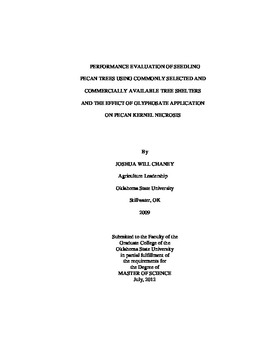| dc.contributor.advisor | Smith, Michael Wayne | |
| dc.contributor.author | Chaney, Joshua Will | |
| dc.date.accessioned | 2014-04-15T22:32:21Z | |
| dc.date.available | 2014-04-15T22:32:21Z | |
| dc.date.issued | 2012-07-01 | |
| dc.identifier.uri | https://hdl.handle.net/11244/9583 | |
| dc.description.abstract | The objectives of these studies were to: 1) evaluate the growth and overall health of seedling pecan trees that were grown in a variety of commonly used physical barriers and commercially available tree protectors/shelters; 2) determine if the use of glyphosate around pecan trees increases the occurrence of kernel necrosis in `Pawnee' pecans; 3) determine if glyphosate drift onto the leaves and/or nuts of `Pawnee' pecans increases the occurrence of kernel necrosis. TP tube unvented and the Protex shelters increased the diameter of seedling pecan trees over the control. Protex Pro/Gro solid tube tree protectors had 65% larger diameter than trees grown in Clipper shelters. While the Protex and Snap n Grow increased the total growth of the seedlings over the control. Total shoot growth of trees grown using Protex Pro/Gro solid tube tree protectors were 64% larger than trees grown using Wholesale Ag shelters. Damaged tissue (caused by Botryosphaeria sp.) was observed on all treatments including the control and did not affect the growth of the seedlings. Trees grown with the black drain pipe had the highest severity of damage, while the Tubex, Corrugated and Protex protectors had the lowest severity of damage. This study indicated that the use of the Protex protectors resulted in the greatest increase in diameter change, cumulative shoot growth and lowest damage severity compared to not using protection around the trunk of the trees during establishment. These studies indicate that glyphosate drift was not the cause of kernel necrosis in `Pawnee' pecans. However, application of glyphosate to the soil around pecan trees increased the occurrence of kernel necrosis by 89% compared to using paraquat. Severe kernel necrosis was 65% higher on trees treated with a glyphosate application to the soil compared to trees treated with only paraquat. Glyphosate sprayed on the trunk of the trees but not on the ground did not increase the occurrence of kernel necrosis, indicating that glyphosate was not taken up by the trunk tissue. Glyphosate application to the tree trunk did not significantly increase the occurrence of kernel necrosis as compared to the paraquat treatment. Therefore, this study indicates that glyphosate applied to the soil is affecting kernel necrosis. | |
| dc.format | application/pdf | |
| dc.language | en_US | |
| dc.publisher | Oklahoma State University | |
| dc.rights | Copyright is held by the author who has granted the Oklahoma State University Library the non-exclusive right to share this material in its institutional repository. Contact Digital Library Services at lib-dls@okstate.edu or 405-744-9161 for the permission policy on the use, reproduction or distribution of this material. | |
| dc.title | Performance Evaluation of Seedling Pecan Trees Using Commonly Selected and Commercially Available Tree Shelters and the Effect of Glyphosate Application on Pecan Kernel Necrosis | |
| dc.type | text | |
| dc.contributor.committeeMember | Smith, Damon | |
| dc.contributor.committeeMember | Rohla, Charles | |
| osu.filename | Chaney_okstate_0664M_12266.pdf | |
| osu.college | Agricultural Sciences and Natural Resources | |
| osu.accesstype | Open Access | |
| dc.description.department | Horticulture and Landscape Architecture Department | |
| dc.type.genre | Thesis | |
| dc.subject.keywords | carya illinoinensis | |
| dc.subject.keywords | glyphosate | |
| dc.subject.keywords | kernel necrosis | |
| dc.subject.keywords | pecan | |
| dc.subject.keywords | tree shelter | |
